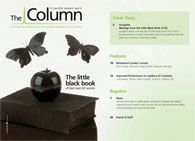The rivers of Madrid
A study performed by researchers from the Madrid Institute for Advanced Studies and the University of Almeria, Spain, has revealed the presence of 88 pollutants in the river waters of Madrid. The research, published in the Journal of Environmental Analytical Chemistry, found that while compounds are to a great extent eliminated at wastewater treatment plants, a fraction remains in the river water.

A study performed by researchers from the Madrid Institute for Advanced Studies and the University of Almeria, Spain, has revealed the presence of 88 pollutants in the river waters of Madrid. The research, published in the Journal of Environmental Analytical Chemistry,1 found that while compounds are to a great extent eliminated at wastewater treatment plants, a fraction remains in the river water.
“Wastewater treatment plants fail to fully degrade many household products, such as biocides and aromas present in creams, toothpaste and shampoo. As a result, they end up in the environment,” said Amadeo R. Fernández-Alba, co-author of the study and professor of chemistry at the university.
To confirm the nature of the compounds, researchers employed a solid-phase extraction method, followed by two methods based on liquid chromatography–mass spectrometry systems with ion trap and time-of-flight analysers. The method detection limits achieved were in the 0.1–60 ng/L range and the concentrations detected ranged from 1–652 ng/L for nine priority substances or candidate pollutants, and from 110–9942 ng/L for 79 emerging pollutants.
The researcher underlines the fact that “there is no imminent danger, as the concentration and toxicity of most of the compounds is low, but the situation must be evaluated and monitored using parameters that guarantee they are harmless both in the short and long term.”
1. María Jesús Martínez Bueno et al., Int. J. Environ. Anal. Chem., 90(3–6), 321–343 (2010).
This story originally appeared in The Column. Click here to view that issue.
HPLC 2025 Preview: Fundamentally Speaking (Part 2)
May 14th 2025Michael Lämmerhofer from the Institute of Pharmaceutical Sciences, University of Tübingen, Germany, spoke to JFK Huber Lecture Award winner of 2024 Torgny Fornstedt, professor in analytical chemistry and leader of the Fundamental Separation Science Group, Karlstad University, Sweden, about his pioneering work in high performance liquid chromatography (HPLC) with a focus on fundamentals, ion-pair chromatography, and oligonucleotide applications.

.png&w=3840&q=75)

.png&w=3840&q=75)



.png&w=3840&q=75)



.png&w=3840&q=75)










